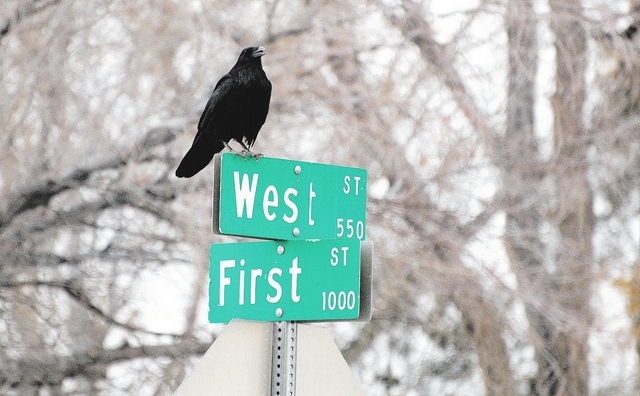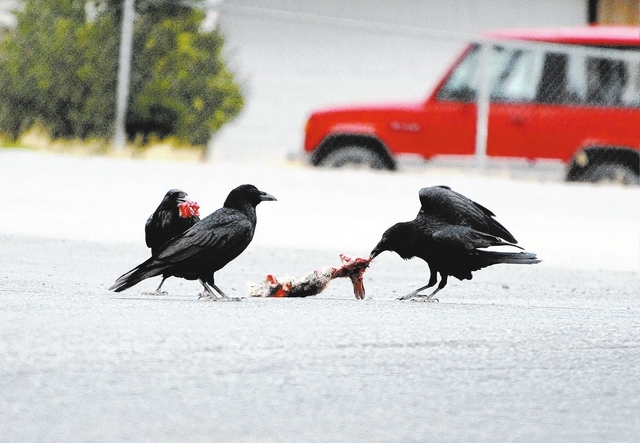Raven declared official nuisance
TONOPAH — Commissioners Tuesday declared the raven a local nuisance and threat to the health, safety and welfare of Nye County residents.
County Commissioner Butch Borasky said he presented the resolution based on an action by the Elko County Commission. The raven was listed as No. 12 on a list of threats to the sage grouse, which could be placed on the endangered species list, an action that would have a major impact on mining and other applications to use public land. The county resolution states ravens and wildfires should be the first and second greatest threat to the sage grouse.
Commissioners Donna Cox and Frank Carbone voted against the resolution.
“The effect of having the sage grouse listed as an endangered species will cost the economy of Nye County hundreds of millions of dollars and thousands of jobs,” the resolution begins. “Predator control is the most effective strategy in protecting the sage grouse population and has the least impact on human development and activity necessary to sustain the health, safety and welfare of society.”
The resolution states a recent scientific study conducted in a part of northern Nevada concluded depredation accounted for 82.5 percent of the nest failures of sage grouse, another study estimated 94 percent. Ravens are responsible for 46.7 percent of the sage grouse nest depredations in northern Nevada. The same studies concluded an increase in one raven for every 10 square kilometers caused a 7.4 percent increase in the probability of greater sage grouse nest failures in parts of northern Nevada.
The resolution adds: “Whereas in addition to depredation on sage grouse, ravens prey on and consume the eggs and the young of song birds and other species during the nesting season and whereas ravens have been observed attacking and pecking out the eyes of newborn calves, lambs and other livestock, particularly during or shortly after birth, causing loss of valuable livestock.”
Because of their tendency to scavenge, the resolution states ravens are known to carry and spread diseases like West Nile virus, fungus and Mad Cow disease, serious health threats to humans, livestock and wildlife.
Raven populations have increased substantially across the western U.S., according to the resolution. Ted Koch, state head of the U.S. Fish and Wildlife Service, confirmed the raven population increased sixfold in the last 30 years.
Commissioner Lorinda Wichman urged caution before the county declares open season on ravens.
“This is a resolution that’s a position statement. I just want people to realize the ravens are a protected species and they are protected by the Migratory Bird Treaty with I believe Canada and Mexico. By putting them in that classification, I believe it is a federal requirement to protect the species,” Wichman said.
But she said western states officials could band together to lobby for a change in the federal regulations.
Carbone asked if the Migratory Bird Treaty was ratified by Congress.
“Until we find out if this treaty has been ratified or not, we need to make sure we don’t give ourselves a black eye,” he said.
Cox explained her opposition to the resolution.
“I have a problem doing anything that might hurt the ecosystem in the future. I know nature takes care of itself,” she said.
Concerns over the listing of the sage grouse have been front and center this week with the Nevada Congressional delegation. U.S. Sen. Harry Reid, in a telephonic press conference Monday, said the Farm Bill that recently passed the Senate includes money for sage grouse conservation programs in an attempt to help prevent the listing.
“It doesn’t do it all, but it’s complementary to what we’re trying to do. This is a very difficult issue because it affects mining and ranching and quite frankly, it affects other interests, hunting, it affects the ability of some communities to grow. So we’re trying to thread this needle. I’ve had some experience with endangered species listings, the most difficult for the state since I’ve been around is the desert tortoise,” Reid said.
“We hope we can do as well with the sage grouse as we’ve done with the desert tortoise. Everyone has to understand it’s not going to be easy,” he said. “We’re trying to do everything we can to stop the listing. Once it’s listed, it’s very difficult.”
Reid said he met with senators from other affected states and added the sage grouse territory doesn’t follow state lines. In Nevada, their prime habitat is in central and northern parts of the state, including northern Nye County. That’s the opposite of the desert tortoise, whose habitat is primarily south of Beatty.
U.S. Sen. Dean Heller, R-Nev., also held a press conference with reporters on Tuesday afternoon to talk about the sage grouse.
Koch told the state Legislative Committee on Public Lands Wednesday that besides predators, wild fires, fed by invasive cheat grass, have torched lots of sage grouse habitat. He said ravens kill endangered desert tortoises as well as sage grouse.
The state could increase agricultural and wildlife permits to kill ravens, he said, but that may not be adequate to removing threats to sage grouse. The ravens typically feed at garbage dumps, on roadkill and use artificial structures like cell phone towers for nesting.
The U.S. Fish and Wildlife Service will make a decision by September 2015 whether to list the sage grouse as endangered, threatened or not to list it, Koch said.
Assemblyman Ira Hansen, R-Sparks, noted the sage grouse habitat loss occurred in a state where 87 percent of the land is under federal management. “So the decline in habitat has been created by the very agencies we’re going to reward by turning over control of the sage grouse issue to the federal government,” he said.


















